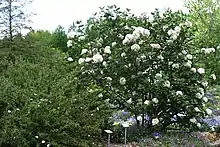| Viburnum carlesii | |
|---|---|
 | |
| Scientific classification | |
| Kingdom: | Plantae |
| Clade: | Tracheophytes |
| Clade: | Angiosperms |
| Clade: | Eudicots |
| Clade: | Asterids |
| Order: | Dipsacales |
| Family: | Adoxaceae |
| Genus: | Viburnum |
| Species: | V. carlesii |
| Binomial name | |
| Viburnum carlesii | |
Viburnum carlesii, the arrowwood[1] or Korean spice viburnum,[2][3] is a species of flowering plant in the family Adoxaceae (formerly Caprifoliaceae), native to Korea and Japan (Tsushima Island) and naturalised in Ohio, USA.[4] Growing to 2 m (7 ft) tall and broad, it is a bushy deciduous shrub with oval leaves which are copper-coloured when young. Round clusters of red buds open to strongly scented, pale pink flowers in late spring. These are followed in late summer by oval red fruits ripening to black in autumn.[5]
The Latin specific epithet carlesii refers to William Richard Carles (1848–1929), a British plant collector in Korea.[6]
The cultivars 'Aurora'[7] and ‘Diana’[8] have gained the Royal Horticultural Society's Award of Garden Merit.[9]
References
- ↑ "Viburnum carlesii". www.rhs.org. RHS. Retrieved 20 September 2019.
- ↑ English Names for Korean Native Plants (PDF). Pocheon: Korea National Arboretum. 2015. p. 672. ISBN 978-89-97450-98-5. Archived from the original (PDF) on 25 May 2017. Retrieved 22 December 2016 – via Korea Forest Service.
- ↑ "Hort.net - Viburnum carlesii". Retrieved 9 May 2013.
- ↑ "Viburnum carlesii". County-level distribution map from the North American Plant Atlas (NAPA). Biota of North America Program (BONAP). 2014. Retrieved 18 May 2019.
- ↑ RHS A-Z encyclopedia of garden plants. United Kingdom: Dorling Kindersley. 2008. p. 1136. ISBN 1405332964.
- ↑ Harrison, Lorraine (2012). RHS Latin for gardeners. United Kingdom: Mitchell Beazley. p. 224. ISBN 9781845337315.
- ↑ "RHS Plant Selector - Viburnum carlesii 'Aurora'". Retrieved 3 April 2020.
- ↑ "RHS Plantfinder - Viburnum carlesii 'Diana'". Retrieved 16 February 2019.
- ↑ "AGM Plants - Ornamental" (PDF). Royal Horticultural Society. July 2017. p. 107. Retrieved 16 February 2019.